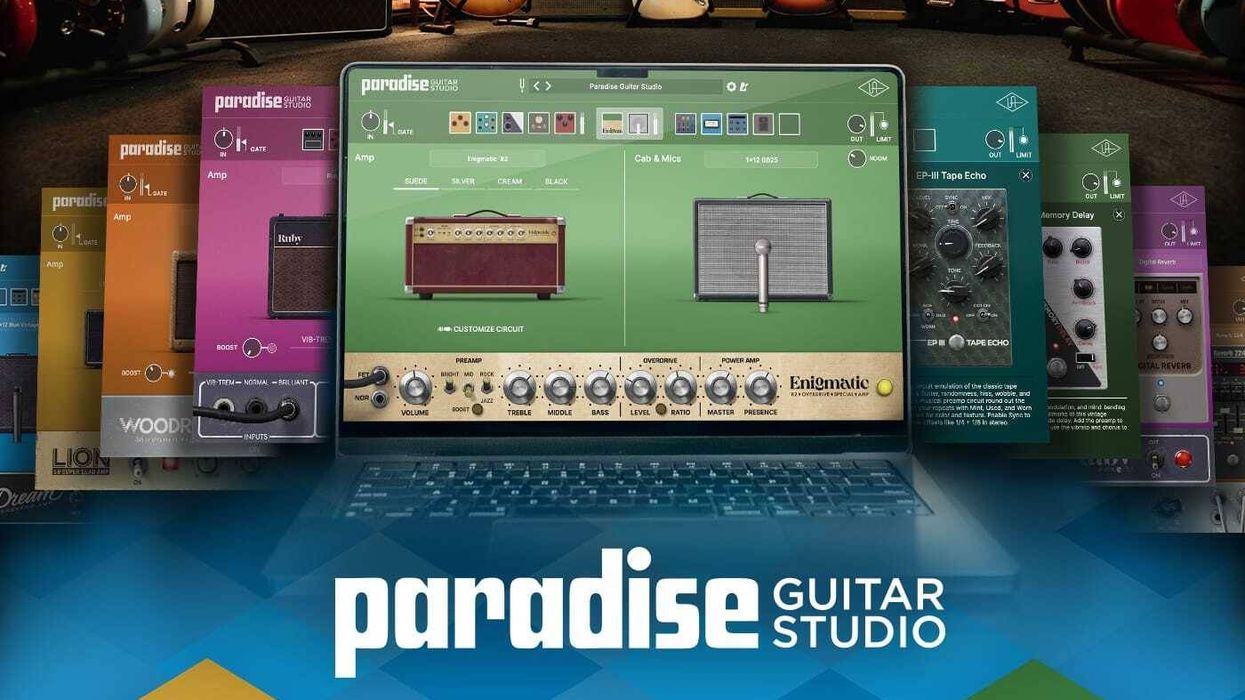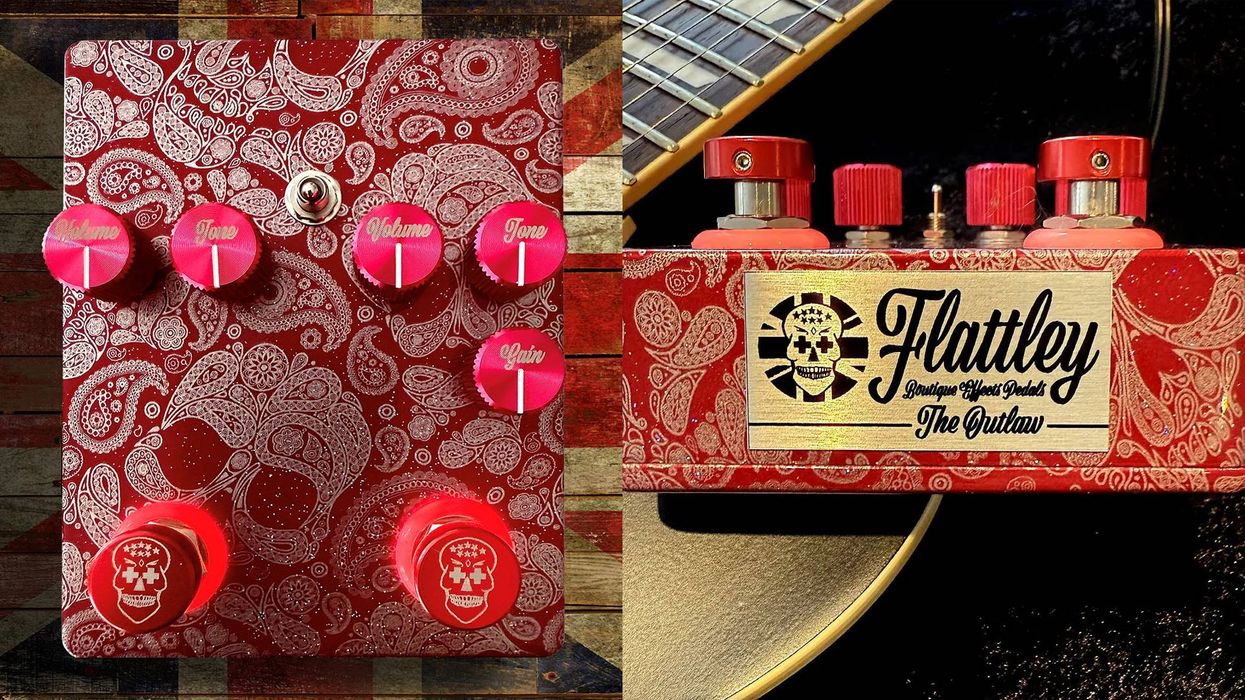Clip 1 - B3K mode engaged, drive and level at 3 o'clock, tone at 1 o'clock, blend at 2 o'clock, gain at 10 o'clock, bass at 11 o’clock, hi mid at 11 o'clock set at 3 kHZ, low mid at 12 o'clock set at 500 Hz, treble at 1 o'clock.
Clip 2 - Microtubes section off, gain and bass at 12 o'clock, hi mid at 8 o'clock set at 750 Hz, low mid at 1 o'clock set at 500 Hz, treble at 9 o'clock.
Clip 3 - VMT mode engaged, drive maxed, level at 1 o'clock, tone at 12 o'clock, blend at 1 o'clock, gain at 9 o'clock, bass at 12 o'clock, hi mid at 1 o'clock set at 750 Hz, low mid at 10 o'clock set at 1 kHZ, treble at 12 o’clock.
For a young company, Finland-based Darkglass Electronics has already made quite a name for itself in the boutique bass gear market. The company’s preamp, overdrive, and compressor pedals are held in high regard for their simplicity and aesthetics, and. most importantly, the tones they generate. The new Microtubes 900—a single-channel, class-D-powered amplifier—represents the company’s maiden voyage into the wide sea of bass amplification. As the name implies, the highly portable amplifier melds their popular Microtubes circuitry with a custom-designed analog preamp and a powerful 900-watt class-D power amp, giving bassists the ability to harness bass tones from crystal clear to crushing overdrive, and everything in-between.
Less Is More
Despite its minimalist aesthetic, the 6 1/2-pound Microtubes 900 is still very much an attention-getter. Its brushed-aluminum chassis looks and feels somewhat similar to Apple’s devices with unibody enclosures—most notably the Mac mini. With its balanced and uniform curves, neat and organized control layout, and compact footprint, the Microtubes 900’s clean style is sure to lure attention from all corners of the room.
Initial tone shaping is handled by the 4-band EQ that’s coupled with dual mid-frequency switches to set the frequency bands for the hi-mids and low-mids controls. When you’re ready to kick things into maximum overdrive, pressing the Microtubes button on the far left will activate the remaining four controls for drive, tone, volume, and wet/dry blending. A distortion-mode switch also comes into play that calls up either the aggressive grit of Darkglass’ B3K CMOS overdrive pedal (B3K) or the warm and spongy growl generated by their Vintage Microtubes stompbox (VMT).
Curiously, the controls for the single-channel amp feel like they’re laid out in reverse order. The main tone-shaping controls are on the right side of the front panel while the Microtubes controls are on the left. It’s not a pressing issue—just an interesting layout that takes some getting used to. A switch for selecting either a passive or active pickup signal lies beneath the input jack, and a mute switch sits above the amp’s master volume knob.
The amp’s rear panel houses 1/4" jacks for connecting an external power amp, preamp, or effects in a serial-loop configuration. There’s an XLR balanced output with switches for ground lifting and pre- or post-EQ signal selection. The amp is equipped with a single Speakon 1/4" combination jack, which, unfortunately, limits its abilities to power multiple cabinets if those cabinets aren’t equipped with parallel jacks for daisy chaining.

Finally, there’s a jack to connect the amp’s included footswitch that either engages or bypasses the Microtubes Engine with a single tap, or mutes the amp entirely by holding the footswitch down for a couple of seconds.
900-Pound Gorilla
Along with a Fender Precision and an Ampeg 8x10 cab, the Microtubes 900 produced a force to be reckoned with. Each of the EQ controls served up an impressive range as I swept through them one by one, pulling back their respective frequencies towards their lowest settings and then dialing them back in towards maximum. I easily coaxed articulate tones by using the gain control to add more compression, which helped even out the volume of individual notes within more intricate fingerstyle patterns.
The bass knob was particularly sensitive to slight adjustments, and I often found myself dialing it back below noon to keep the P’s hefty thump from overshadowing the mids and treble. But even when I did set it closer to 3 o’clock—which unleashed ungodly amounts of bass—the delivery remained solid, firm, and crystal clear without any congestion or loss of low-end smoothness. While these traits are somewhat common in class-D-powered bass amps, I have come across very few that pull it off as well as the Microtubes 900.
Ratings
Pros:
Sturdy and cool-looking build. Supremely smooth and powerful tones with fat lows. Versatile overdrive sounds to die for.
Cons:
Single speaker jack limits cab configurations, unless your cabs have parallel jacks. Slightly pricey.
Tones:
Ease of Use:
Build/Design:
Value:
Street:
$999
Darkglass Microtubes 900
darkglass.com
I was a little skeptical when I first realized the ranges for the low- and hi-mids controls were limited to three frequency bands each, but I quickly came around after spending some time with them. They’re set to some of the most commonly tweaked frequency bands used for bass, and each can shape the tone dramatically. For example, I’m partial to tones with a kick in the 750-800 Hz range, which is where a lot of the attack and other overtones the human ear is most responsive to sit within a bass tone.
With the hi-mids control switch set to 750 Hz, the hi-mids knob effectively became a cut control for me, which gave me the ability to quickly pull more of my tone through during the cacophony of band practice—thus saving me from having to turn up the volume and deal with ensuing dirty looks from bandmates.
One quick tap of the footswitch kicked in the amp’s Microtubes Engine section, which ultimately proved to be the coolest part of this amp that had already been hitting high marks everywhere else. The differences between the VMT and B3K overdrive modes were pretty distinct, with the former having a more symmetric midrange-focused clipping, while the latter dished out more modern and razor-edged tones. With the P bass and a handful of driving bass lines at the ready, the VMT mode served up a corpulent overdrive with a beautiful tube-like compression and excellent sensitivity to changes in my string attack.
The B3K mode stood in stark contrast, with a much sharper and woolly drive that pushed my tone into an industrial-laden world of grind while visiting the higher ranges of the drive control. I had a blast pumping out harder-tinged bass lines (à la the Jesus Lizard and Young Widows) with a pick and setting the blend control a little more towards the drive side—which is a sound I typically try to cop with a DI, a Rat, and a big tube amp. With the Microtubes B3K mode and the right settings, I could barely tell the difference.
The Verdict
The Darkglass Microtubes 900 stands out within the increasingly populated market of class-D bass amps. It’s a hell of an entrance for the company’s first foray into the world of amplification. It does a superb job of handling a wide frequency spectrum while possessing the ability to tweak the all-important midrange frequencies that make or break a truly great bass tone. The overdrive produced by its Microtubes Engine can cover a wide gamut of tones and has enough on tap to make you think twice about keeping that Rat or Big Muff on your pedalboard. It’s a little pricier than its contemporaries on the market, but, to me, the extra cash is worth it for the knockout build quality and killer tone.







![Rig Rundown: AFI [2025]](https://www.premierguitar.com/media-library/youtube.jpg?id=62064741&width=1245&height=700&quality=70&coordinates=0%2C0%2C0%2C0)












 Shop Scott's Rig
Shop Scott's Rig















































